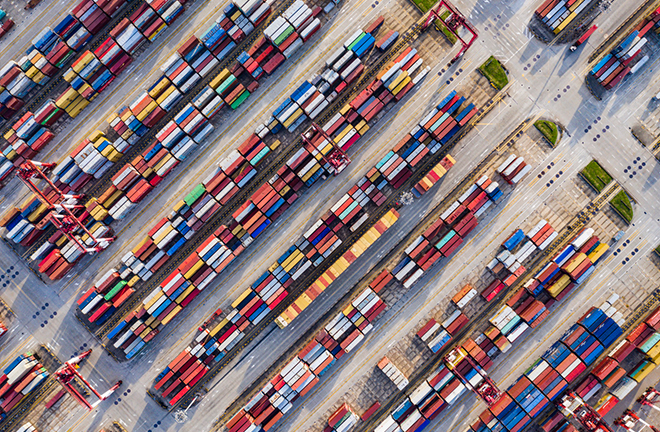Scholars praise CPC plenum resolution

An aerial view of containers at the Shanghai Yangshan Deep Water Port, the world’s biggest automated container terminal Photo: TUCHONG
Academics have lauded the Resolution of the CPC Central Committee on Further Deepening Reform Comprehensively to Advance Chinese Modernization for its clarity in defining the themes, overarching objectives, major principles, key measures, and fundamental guarantees for all-around reform deepening, viewing it as providing significant guidance for advancing modernization on the new journey in the new era.
Adopted at the Third Plenary Session of the 20th CPC Central Committee concluded on July 18, the Resolution is a comprehensive document spanning 15 sections divided into three main parts. A landmark document, it outlines over 300 crucial reform measures, drawing a holistic roadmap for further deepening reform comprehensively across various domains, including the economy, politics, culture, society, ecological conservation, Party building, national defense, and the military.
Economic structural reform
“Deepening reform comprehensively is about building a high-standard socialist economy with economic structural reform as the spearhead,” said Huang Qunhui, director of the Institute of Economics at the Chinese Academy of Social Sciences (CASS).
According to the National Bureau of Statistics, China’s GDP hit 61.6836 trillion yuan (approximately $8.507 trillion) in the first half of 2024, up 5.0% year-on-year. The national economy has maintained its recovery momentum, progressing amid stability overall.
Huang noted that since the new era, China has made remarkable achievements in economic structural reform, manifested in positive results in the construction of a unified, open market system featuring orderly competition, the accelerated formation of an efficient, well-regulated unified national market, and substantially more market-oriented, law-based, and internationalized business environments.
By the end of 2023, China had 184 million registered business entities nationwide, including over 53 million private enterprises, which represents increases of 2.3 and 3.9 times, respectively, since 2012. Huang pointed out that the macroeconomic governance system has steadily improved alongside modernization in macroeconomic governance capabilities.
According to the Resolution, high-quality development is the primary task in building China into a modern socialist country in all respects. In Huang’s view, China is still plagued by many deep-seated contradictions and suboptimal systems and mechanisms, as established economic growth drivers are inadequate to meet the requirements of high-quality development. Moreover, the new sci-tech revolution, recent industrial reforms, and transformative changes in the demographic structure pose new challenges to achieving both qualitative and quantitative economic growth.
This situation necessitates that China prioritizes reform to develop effective systems and mechanisms for high-quality development, thereby advancing Chinese modernization, Huang said.
Rural revitalization
What does all-around reform deepening mean for rural areas? Zhang Qi, director of the China Rural Revitalization and Development Research Center at Beijing Normal University and a researcher with over three decades of focus on agriculture and rural development, has closely followed the dramatic transformations in China’s rural economy and society since the 18th CPC National Congress.
Zhang Qi has observed both marked successes in preventing a large-scale return to poverty and steady progress in urban-rural integration. Modern agricultural technologies and equipment have seen continuous upgrades, while grain output has remained stable at over 1.3 trillion jin (650 billion kilograms) for several years consecutively, laying a solid foundation for food security. Additionally, rural infrastructure—including roads, hydraulic engineering, electric power, and communication—continues to improve, significantly enhancing production and living conditions in the countryside. Support systems for strengthening agriculture, benefiting farmers, and enriching rural areas have been refined, contributing to steadily increasing rural incomes.
These reform achievements in agriculture, rural areas, and the lives of rural citizens have established a robust foundation for realizing rural revitalization and advancing Chinese modernization, Zhang Qi said.
Ecological conservation
Chinese modernization is the modernization of harmony between humanity and nature. Zhang Yongsheng, director of the Research Institute for Eco-civilization at CASS, emphasized that the Resolution attaches high importance to ecological conservation and outlines reform and development plans based on harmony between humanity and nature, detailing arrangements on refining the system for ecological conservation and guiding related reforms.
At present, the green economy, represented by new energy vehicles, lithium batteries, and photovoltaic products, has become a new growth driver for the Chinese economy, with the construction of a “Beautiful China” as a pivotal source of growth, Zhang Yongsheng noted. The modernization of harmony between humanity and nature will cultivate a synergistic and complementary relationship between the ecological environment and economic development. Guided by the principles of ecological civilization, China is poised to achieve remarkable new growth through green development, he predicted.
National governance
The Resolution also stresses the importance of upholding and improving the system of socialism with Chinese characteristics while modernizing China’s system and capacity for governance. Du Zhizhang, deputy director of the Institute of State Governance at the Huazhong University of Science and Technology, spoke highly of such local governance models as the Shunde model, which involves close collaboration between Party and state departments; the Shenzhen model, featuring the separation of decision-making, execution, and supervision in administration; and the Chengdu model of governing urban and rural areas in a coordinated manner.
The maturing socialist system with Chinese characteristics and China’s increasingly modernized governance system and capacity since the new era are demonstrated by the accelerated transformation of government functions, enhanced administrative efficacy, and optimized collaboration between Party and state departments, Du said.
The rule of law provides an important guarantee for Chinese modernization. Yang Song, president of Shenyang Normal University, held that reforms are fundamental to solving pronounced problems within the rule of law. He said that reforms of the judicial system are actively underway across China, including the overhaul of judicial accountability, classified staff management of public institutions through selection, trial-centered criminal prosecution, the “full coverage” of circuit courts of the Supreme People’s Court, and the creative “one-stop” diversified international business dispute resolution mechanism.
Yang added that these judicial reform measures are intertwined and effective in practice, solidifying the foundation for the modernization of the rule of law in China.
Edited by CHEN MIRONG

 PRINT
PRINT CLOSE
CLOSE